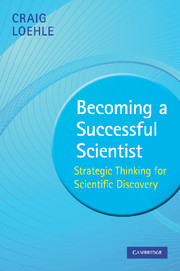2 - The inner game of science
Published online by Cambridge University Press: 05 June 2012
Summary
Science is about mathematics and rigor, but the human mind is sloppy and vague. We are prone to jumping to conclusions, prefer short chains of logic, are easily duped by optical illusions (even when told they are illusions beforehand), and are influenced by group think. This section is about the inner game of science, the mental world where discovery and proof take place. This is the terra incognita that few scientists have thought about, but about which they remain ignorant at their peril. A strategic approach to problem solving is presented and applied to help elucidate the solution to the paradox of how our illogical mind can ever produce reliable, logical results.
Because scientific discovery is inherently about open-ended, complex problems, it is not really possible to apply a cookbook approach (“the scientific method”). Rather, I suggest that a strategic approach to problem solving is a more effective approach. For those who are not born strategists, this involves tuning up one's thinking machinery specifically for this type of problem. Specifically, there are three steps to creating successful novel products. First, one must be capable of generating novel (but useful) ideas, of overcoming routine ways of functioning, and of putting together information in new ways. Without this capacity, one is limited to solving problems defined by others (the definition of a drone). Second, one must be able to use this creative capacity to discover/invent something new.
- Type
- Chapter
- Information
- Becoming a Successful ScientistStrategic Thinking for Scientific Discovery, pp. 23 - 129Publisher: Cambridge University PressPrint publication year: 2009



